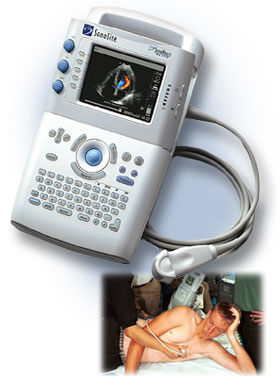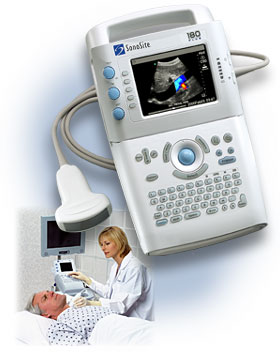Medical Ultrasound Imaging
Thursday, 3 April 2025
'SonoSite, Inc.' Searchterm 'SonoSite, Inc.' found in 5 articles 1 term [ • ] - 4 definitions [• ] Result Pages : • SonoSite, Inc.  'SonoSite, Inc. is the worldwide market and technology leader in high performance, hand-carried ultrasound. Through its expertise in ASIC design, SonoSite is able to offer imaging performance typically found in ultrasound systems weighing more than 300 pounds in a system architecture that is approximately the size and weight of a laptop computer and provides a significant price to performance advantage compared to conventional systems. This breakthrough is transforming and expanding the worldwide diagnostic ultrasound market by serving existing clinical markets more efficiently and creating new point-of-care applications where ultrasound was either too cumbersome or too expensive to be used before. With over 15,000 systems sold since 1999, SonoSite products are known for exceptional performance, ease of use and durability.'
'SonoSite, Inc. is the worldwide market and technology leader in high performance, hand-carried ultrasound. Through its expertise in ASIC design, SonoSite is able to offer imaging performance typically found in ultrasound systems weighing more than 300 pounds in a system architecture that is approximately the size and weight of a laptop computer and provides a significant price to performance advantage compared to conventional systems. This breakthrough is transforming and expanding the worldwide diagnostic ultrasound market by serving existing clinical markets more efficiently and creating new point-of-care applications where ultrasound was either too cumbersome or too expensive to be used before. With over 15,000 systems sold since 1999, SonoSite products are known for exceptional performance, ease of use and durability.''SonoSite began as a division of ATL Ultrasound in 1997 focused on the development of all-digital, handheld ultrasound devices. In February 1995, the U.S. Defense Advanced Research Project Administration (DARPA) had awarded to ATL a two-year matching grant to develop a highly portable ultrasound device for use on the battlefield or in natural or man-made disasters to diagnose victims of severe trauma. This program culminated with a prototype in October 1998. ATL spun off SonoSite as a public company on April 6, 1998.' In March 2012 Fujifilm Holdings completes the acquisition of SonoSite. Ultrasound Systems:
Contact Information
MAIL
SonoSite, Inc.
U.S. Headquarters 21919 30th Drive SE Bothell, WA 98021-3904
PHONE
+1 425 951 1200
(+1 888 482 9449)
FAX
+1 425 951 1201
ONLINE
Contact Page
• • •  From SonoSite, Inc.;
From SonoSite, Inc.;'Introducing the SonoSite TITAN, a high-resolution modular ultrasound solution. TITAN provides health care professionals with state of the art high-resolution imaging wherever needed for responsive, rapid patient care. The TITAN system's modular design includes three major benefits: Stationary and mobile usage. Point-of-care connectivity. Flexible, cost-effective paths that enable users to acquire new components and software applications.' • Result Pages : |
Medical-Ultrasound-Imaging.com
former US-TIP.com
Member of SoftWays' Medical Imaging Group - MR-TIP • Radiology TIP • Medical-Ultrasound-Imaging
Copyright © 2008 - 2025 SoftWays. All rights reserved.
Terms of Use | Privacy Policy | Advertise With Us
former US-TIP.com
Member of SoftWays' Medical Imaging Group - MR-TIP • Radiology TIP • Medical-Ultrasound-Imaging
Copyright © 2008 - 2025 SoftWays. All rights reserved.
Terms of Use | Privacy Policy | Advertise With Us
[last update: 2023-11-06 01:42:00]





 From
From  From
From  From
From